The iPhone 7 and iPhone 7 Plus Review: Iterating on a Flagship
by Joshua Ho & Brandon Chester on October 10, 2016 8:00 AM EST- Posted in
- Smartphones
- Apple
- Mobile
- iOS
- iOS 10
- iPhone 7
- iPhone 7 Plus
Battery Life
As-is, one of the most important factors for upgrading a smartphone remains battery life, due to a combination of inherent demand for a phone that can last 2-3 days of use and applications that demand enormous amounts of performance over long periods of time. Apps like WeChat are fairly notorious for holding wakelocks on Android and never really stopping background resource usage so there’s also an element of OS optimization that goes with keeping real-world in battery life up to expectations.
In order to test these things, we’ve spent the past year developing and validating a new web browsing battery life test which updates the sites used and introduces a scrolling component which attempts to better model how a number of tasks are not simply race to sleep and contain a steady-state component. We’ve also updated our rundown tests to better reflect reality and maintain appropriate loads as some devices with high-end SoCs and low display resolution were outpacing our testing. As always, all displays are set to 200 nits with location and other background services disabled to reach a useful relative comparison.

Looking at our WiFi web browsing test, it’s genuinely ridiculous how well the iPhone 7 and 7 Plus perform in this test. The iPhone 7 Plus is definitely down on battery life compared to the Galaxy S7 Edge, but it’s within 5% despite using a battery that’s almost 20% smaller. The iPhone 7 is actually comparable in battery life to the iPhone 7 Plus, and is significantly above the Galaxy S7 with Exynos 8890. Of course, the iPhone 7 has a significantly lower resolution display and a smaller battery, but the nature of smartphone design is that larger devices will generally have better battery life because the board area needed remains mostly constant while the amount of area for battery increases. The iPhone 7 has significantly improved in battery life here, likely due to a combination of A10 Fusion's power optimizations – particularly the small CPU cores – and the removal of the headphone jack, which teardown photos show to have been partially replaced with the battery. However if you do the math efficiency sees a relatively minor uplift.
One other interesting point is that Brandon accidentally ran the battery test on his iPhone 7 with a Safari Content Blocker enabled, which blocked all the ads on the sites that the test visits. In doing so, battery life rose from the normal result of 9.22 hours to 10.03 hours, demonstrating how the increased workload and long-running network requests from ads and trackers really impacts a smartphone's battery life. It's also worth noting that our test constantly cycles through pages, so if you spend a lot of time on a single page with ads you could see an even greater difference.
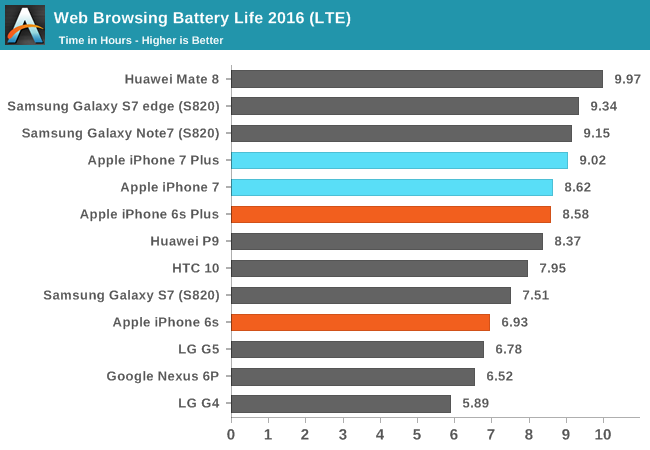
Moving on to LTE battery life the iPhone 7 and 7 Plus both slip a bit, but remain impressive. I suspect that the 20nm Qualcomm modem here is not well-equipped to handle the endless stream of ads that is increasingly a part of most websites. As ads tend to stream in incredibly slowly, the standby power of the modem is a significant factor. Snapdragon 820 devices don’t see nearly the impact here that the iPhone 7 and 7 Plus as their modem is on 14LPP rather than 20SoC. The iPhone 7 remains above the S820 Galaxy S7, but the iPhone 7 Plus is fairly comparable to the iPhone 6s Plus in battery life on LTE.

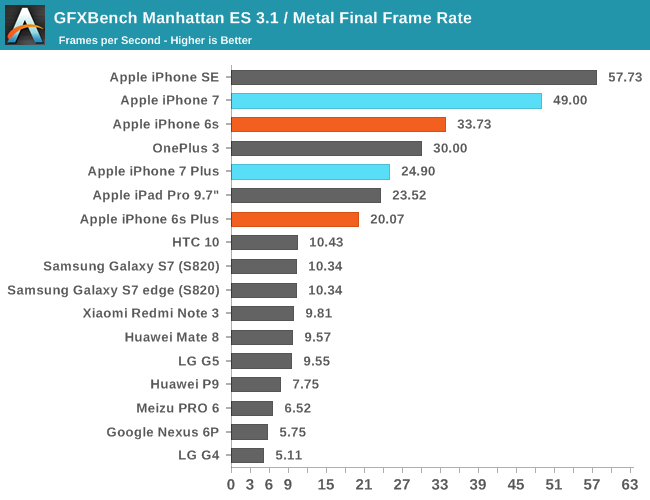
Moving past the web browsing test we use we can take a look at how the iPhone 7 Plus throttles. Unfortunately Basemark OS II was basically broken in this regard for the CPU rundown test so we can only look at how it behaves on Manhattan 3.1, but it's interesting to see how the GPU performance drops about 40% for the iPhone 7 Plus while the iPhone 7 throttles around 20%, because even Manhattan 3.1 is pegged to vsync which means that the GPU can spend much more time idling once a given frame is rendered. It's probably not a surprise here but the iPhone 7 just doesn't last very long here because battery life is strongly SoC-bound. If you attempted to plot battery life as a function of overall SoC utilization, it's entirely possible that the iPhone 7 might last longer than the 7 Plus at the lower bound for utilization, but as soon as you go past web browsing and similarly "light" tasks the 7 Plus and most phablets are going to strongly outperform such a small phone. Here the larger battery helps to get the iPhone 7 Plus nearly another hour of battery life when the SoC is under full, continuous load.
Charge Time
As usual, while battery life is the salient characteristic that determines overall mobility, it’s important to not ignore charge time as there are a number of edge cases where charging has a significant impact on overall mobility. In order to test this we use power measurements at the wall and measure the time it takes from the moment that the charger is plugged in to the moment that it falls below a pre-determined draw from the wall. While this isn’t perfect due to varying levels of DC conversion efficiency and different methods of trickle charging, this method provides at least a reasonable approximation of how long it will take to charge a device.
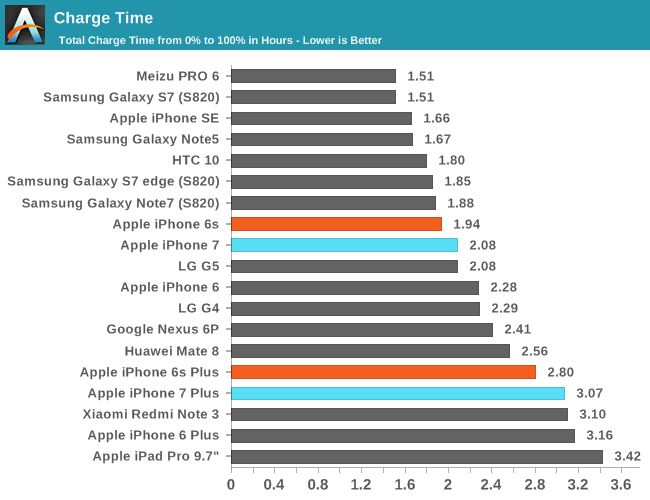
In the case of the iPhone 7 and 7 Plus, Apple continues to ship their standard 5W chargers for US variants. Looking at the results, it’s probably obvious that at least in the case of the iPhone 7 Plus, there is a very real need for Apple to start shipping something with faster charging, as the standard 5W charger takes a full hour longer than most of its competition to charge to 100%. Even the iPhone 7 could use a higher power charger here as using the device while it is charging will significantly impact the charging rate as the charger cannot supply enough power to the board while also charging the battery. And in the case of both phones, the lack of a high power charger doesn't just draw out the total charge time, but it also precludes rapid charging (partially charging a depleted phone very quickly) as well.
It would really be prudent for Apple to start to transitioning to higher power AC adapters at this point. This doesn’t take away from how impressive battery life is, but overall mobility isn’t going to be better than the competition unless you go out of your way to buy an iPad charger.


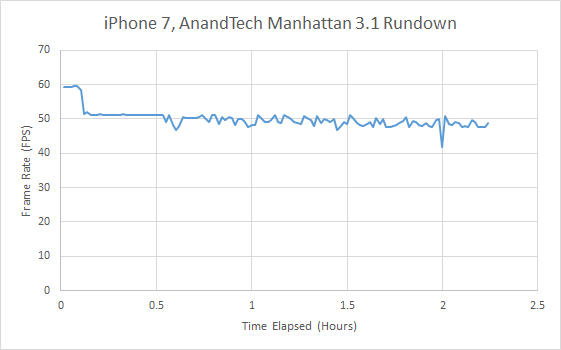
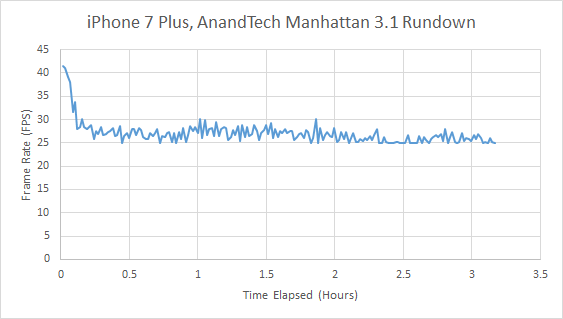
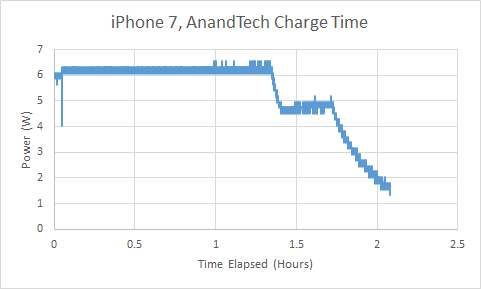
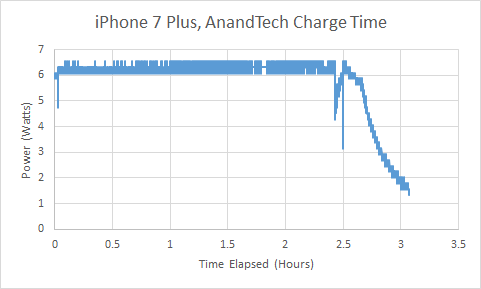








377 Comments
View All Comments
indifferent - Wednesday, October 12, 2016 - link
I second blackcrayon, UtilityMax you need to read more about iphone.UtilityMax - Wednesday, October 12, 2016 - link
I don't need to read more about the iphone. I have used all the models up tp 5S. There is no way to upload my media into the iphones without using the garbage software that's known as itunes. (The last time I installed it on a PC, it literally deleted my BluRay drive), There are some also very ridiculous an inferiour methods to by pass that such as the using a third party software like VLC. None of that works as well as plugging my android phone with USB cable into a PC and copy/paste directly all the files that I need on the phone.blackcrayon - Wednesday, October 12, 2016 - link
Ahh, I guess you meant to say there is no way to upload music to the stock music app (unless you use streaming/cloud which I find a much better solution anyway), or upload photos to the stock photos app (unless you stream, which I find a much better solution anyway). You didn't clarify. But you still don't *need* iTunes to put "media" on the phone. Also, you might consider that 802.11ac probably gets data onto an iPhone faster than using USB at this point...jlabelle2 - Thursday, October 13, 2016 - link
No Blackcrayon, UtilityMax is correct. If I want to put my FLAC on my iPhone (because Qobuz and others sites only propose FLAC and not ALAC), I need to 1/ open iTunes, 2/ look for the apps section, 3/ find the app like VLC that allow file transfer 4/ make a drag-n-drop, 5/ turn on the app on the iPhone and wait the synchronization.That is really CRAZY that in 2016, you just cannot simply drag-n-drop from the computer on the iPhone.
"unless you use streaming/cloud which I find a much better solution anyway"
if you do not care about audio quality, have unlimited data, and have ALWAYS an internet connection wherever you are, 100% of the time, ...yeah, it can be a good enough solution for you.
"Also, you might consider that 802.11ac probably gets data onto an iPhone faster than using USB at this point"
The time where you will even remotely transfer as fast 30Go of music with wifi than USB you will call me buddy. But you are in dreamland.
techconc - Thursday, October 13, 2016 - link
No jlabelle2, blackcrayon is correct. There are multiple solutions for accomplishing file transfer without iTunes. Some as simple as AirDrop. For PC users, there are file transfer apps. There are cloud solutions, including iCloud itself. I would suggest that the majority of iPhone users don't even use iTunes at all anymore for any sort of phone syncing. This isn't 2007 anymore... time to update our memes.jlabelle2 - Friday, October 14, 2016 - link
"Some as simple as AirDrop"No help, I have a Windows PC, like 93% of the population out there. Beside, can you AirDrop FLAC?
"For PC users, there are file transfer apps"
Great, so your answer to "you have to use a special program like iTunes to transfer dumb things like music" is "no, not true, you can use ANOTHER special program"???
What an answer is that?
"There are cloud solutions, including iCloud itself."
How do you transfer FLAC into your iPhone with iCloud? Could you share your workflow?
"This isn't 2007 anymore... "
It is and this what we are complaining. Changing ringtones, putting some music in your phone... in 2016? like we were 10 years ago? Really?
techconc - Monday, October 17, 2016 - link
Your complaints seem to be focused on FLAC. For starters, if you insist on using FLAC, you can do so with VLC, etc. It's not a real barrier. For that matter, you ask about alternate workflows. Have you tried something like WALTR? It's a free application that's available on both Mac and Windows. It allows for drag and drop of your media in basically any format, including FLAC. You drag and drop the files onto the application and it does real time conversion (losslessly in the case of FLAC) to a native iOS format in order to work properly with native apps. The point being, even your edge case scenarios have viable solutions.adrift02 - Wednesday, October 12, 2016 - link
You mentioned UI fluidity in the review, and that none of the recent iPhones are the most fluid mobile devices you've used. So what device tops them? I'm asking because that's why I switched to iOS when the iPhone 5 was released -- I was sick of animation stutters and progressive slowdown among Android devices. I'm now looking to switch back to Android (for audio reasons, as I want a headphone jack and the 7 dongle's DAC wasn't great) but am torn re: choices. I'd like an experience that's as smooth as iOS and am considering the Pixel (waiting for reviews), as well as the V20 (just for the DAC, but it's waaay to big for me).Crono - Thursday, October 13, 2016 - link
Disable animations in developer options. Install Nova Launcher, enable Aggressive Desktop, select "Faster than light" in animations. On a clean ROM or.a debloated device - I'm using am Honor 8 - it's a less stuttery/faster UI than the iPhone 7 fresh out of the box.Crono - Thursday, October 13, 2016 - link
^ please ignore the typos, it was a quick reply and there's no edit feature :(